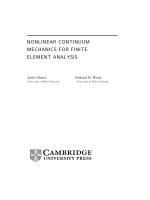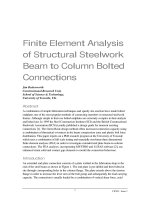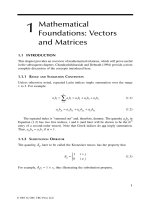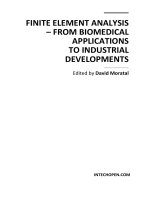finite element analysis g. lakshmi narasaiah
Bạn đang xem bản rút gọn của tài liệu. Xem và tải ngay bản đầy đủ của tài liệu tại đây (11.45 MB, 349 trang )
Finite
Element
Analysis
G.
Lakshmi Narasaiah
Prof. & Head Aeronautical Engineering Dept.
MLR
Institute
of
Technology
Dundigal,
Hyderabad 500 043
Formerly Senior Manager,
Corp.
R&D,
BHEL Vikasnagar, Hyderabad 500 093
BSP
BS
Publications
==iiii
4-4-309, Giriraj Lane, Sultan Bazar,
Hyderabad -
500 095 -
AP.
Phone:
040-23445688
Copyright © 2008, by Author
All rights reserved /
No part
of
this book
or
parts thereof may be reproduced, stored in a retrieval
system or transmitted in any language
or
by any means, electronic, mechanical,
phototcopying, recording or otherwise without the prior written permission
of
the Author.
"This book references ANSYS software, Release (Ed 5.5)
is
used by the author
and
should not be considered the definitive source
of
information regarding the
ANSYS program. Please consult the ANSYS product documentation
for
the release
of
ANSYS with which you are working
for
the most current information
".
Published by :
BSPBS
Publications
Pr;ntedat
4-4-309, Giriraj Lane, Sultan Bazar,
Hyderabad - 500 095 -
A.
P.
Phone:
040-23445688
Fax:
91+40-23445611
e-mail:
Adithya
Art
Printers
Hyderabad.
ISBN:
978-81-7800-140-1
Contents
Chapter 1
Introduction 1-34
1.1
Design and Analysis
of
a Component 1
1.2
Approximate Method vs. Exact Method 4
1.3
Weighted Residual Methods 5
1.4
Variational Method or Rayleigh - Ritz Method
12
1.5
Principle
of
Minimum Potential Energy
22
1.6
Origin
ofFEM
26
1.7
Principle
ofFEM
27
1.8,
Classification ofFEM
31
1.9
Types
of
Analyses
32
1.10
Summary
33
Objective Questions 33
Chapter 2
Matrix
Operations 35-60
2.1
Types
of
Matrices
35
2.2 MatrixAlgebra
~
37
Contents
(xiv)
2.3
Detenninant
39
2.4 Inversion
of
a Matrix
41
2.5
Methods
of
Solution
of
Simultaneous Equations
41
2.5.1
By Inversion
of
the Coefficient Matrix
42
2.5.2 Direct Methods
44
2.5.3 Iterative Methods
53
2.6 Eigen Values and Eigen Vectors
55
2.7 Matrix Inversion Through Characteristic Equation
59
2.8 Summary
60
Chapter 3
Theory
of
Elasticity
61-84
3.1
Degrees
of
Freedom
61
3.2 Rigid Body Motion
62
3.3 Discrete Structures
62
3.4 Continuum Structures
62
3.5 Material Properties
63
3.6 Linear Analysis
63
3.7 Non-linear Analysis
63
3.8 Stiffness and Flexibility
64
3.9 Principle
of
Minimum Potential Energy
65
3.10 Stress and Strain at a Point
65
3.11
Principal Stresses
68
3.12 Mohr's Circle for Representation
of
2-D Stresses
68
3.13
VonMises Stress
71
3.14 Theory
of
Elasticity
72
3.15 Summary
82
(xv)
Contents
Chapter 4
Discrete (1-D) Elements
85-125
4.1
Degrees
of
Freedom
of
Different Elements
85
4.2 Calculation
of
Stiffness Matrix by Direct Method
86
4.3
Calculation
of
Stiffness Matrix by Variational Principle
88
4.4 Transformation Matrix
92
4.5 Assembling Element Stiffness Matrices
94
,
4.6 Boundary Conditions
96
4.7 Beam Element Stiffness Matrix by Variational Approach
98
4.8 General Beam Element
100
4.9 Pipe Element
103
4.10 Summary
104
Objective Questions 105
Solved Problems 108
Chapter 5
Continuum (2-D
& 3-D) Elements
127-158
5.1
2-D Elements Subjected to In-plane Loads
127
5.2 Simplex, Complex and Multiplex Elements
128
53
Stiffness Matrix
of
a CST Element
129
5.3.1
Stiffness Matrix
of
a Right Angled Triangle
131
5.4 Convergence Conditions
133
5.5
Geometric Isotropy
136
5.6 Aspect Ratio
138
5.7 Inter-Element Compatibility
139
5.8 2-D Elements Subjected to Bending Loads
141
5.9 3-D Elements
143
Contents
(xvi)
5.
JO
Axi-symmetric Elements
144
5.11
Summary
146
Objective Que!t,tions • 147
Solved
Problen'!~
152
Chapter 6
Higher
Order and Iso-Parametric Elements 159-199
6.1
Higher Order Elements
159
6.2 Isoparametric Elements
169
6.3
Stiffness Matrices
of
Some Iso-parametric Elements
170
6.4 Jacobian
182
6.5
Strain-displacement Relations
184
6.6 Summary
188
Objective Questions 189
Solvetl Problems 190
Chapter 7
Factors Influencing Solution
201-236
7.1
Distributed Loads
201
7.2 Statically Equivalent Loads vs. Consistent Loads
202
7.3
Consistent Loads for a Few Common Cases
206
7.4 Assembling Element Stiffness Matrices 209
7.5
Automatic Mesh Generation 214
7.6
Optimum Mesh Model
215
7.7 Gaussian Points & Numerical Integration 216
7.8 Modelling Techniques 220
7.9 Boundary Conditions for Continuum Analysis 224
7.10 Transition Element 228
(xvii)
Contents
7.11
Substructuring or Super Element Approach 230
7.12 Deformed and Undeformed Plots
231
7.13
Summary
232
Objective Questions • •.• • • • •.• • 233
Chapter
8
Dynamic Analysis (undamped free vibrations)
237-253
8.1
Normalising Eigenvectors 239
8.2 Modelling for Dynamic Analysis 240
8.3
Mass Matrix 240
8.4 Summary
251
Objective Questions .• •.• ••.• • 252
Chapter
9
Steady State
Heat
Conduction
255-276
9.1
Governing Equations
255
9.2
1-0
Heat Conduction 257
9.2.1 Heat Conduction Through a Wall
258
9.2.2 Heat Transfer Through a Fin 268
9.3 2-D heat Conduction
in
a Plate
273
9.4 Summary
275
Objective Questions • •• •• •• • • •
276
Chapter
10
,
Design Validation
and
Other
Types
of
Analysis 277-291
10.1
Compliance with Design Codes 277
10.2 Transient Heat Condition
281
10.3
Buckling
of
Columns 282
Contents
(xviii)
10.4 FatigueAnalysis
283
10.5
Creep Analysis
285
10.6 Damped Free Vibration 287
10.7 Forced Vibration 288
10.8
Torsion
of
a Non-circular Rod 289
Chapter
11
Computational Fluid Dynamics 293-307
11.1
Introduction
293
11.2
Governing Equation 294
11.3
Finite Difference Method (FDM) 296
11.4
Elliptic Equations (or boundary value problems) 297
11.5
Finite Volume Method (FVM) 305
11.6
FDM vs. FEM
:.
307
Chapter
12
Practical Analysis Using a Software
309-329
12.1
Using a General Purpose Software 309
12.2 Some Examples with ANSYS
311
Objective Questions •• • • • •• • •.•.• •.• •••••.• •• •.•••.
326
Answers
•••.•.• • • •.•.•.••••• • • • • •••••••••.•••••.•••
331
References
for
Additional
Reading
.• •.•.•• • • •••.•.••••.••••.•• •
333
Index
335
CHAPTER
1
INTRODUCTION
1.1. DESIGN
AND
ANALYSIS
OF
A
COMPONENT
Mechanical design
is
the design
of
a component for optimum size, shape, etc.,
againstfailure under the application
of
operational loads. A good design should
also minimise the cost
of
material and cost
of
production. Failures that are
commonly associated with mechanical components are broadly classified as:
(a) Failure by breaking
of
brittle materials and fatigue failure (when
subjected to repetitive loads)
of
ductile materials.
(b) Failure by yielding
of
ductile materials, subjected to non-repetitive
loads.
(c) Failure by elastic deformation.
The last two modes cause change
of
shape or size
of
the component
rendering it useless and, therefore, refer to functional or
operational failure.
Most
of
the design problems refer to one
of
these two types
of
failures.
Designing, thus, involves estimation
of
stresses and deformations
of
the
components at different critical points
of
a component for the specified loads
and boundary conditions, so as to
satisfY
operational constraints
Design
is
associated with the calculation
of
dimensions
of
a component to
withstand the applied loads and perform the desired function.
Analysis
is
associated with the estimation
of
displacements or stresses
in
a component
of
assumed dimensions so that adequacy
of
assumed dimensions
is
validated.
Optimum design
is
obtained by many iterations
of
modifYing dimensions
of
the
component based
on
the calculated values
of
displacements and/or stresses
vis-a-vis permitted values and re-analysis.
An analytic method
is
applied to a model problem rather than to an actual
physical problem.
Even many laboratory experiments use models. A geometric
model
for analysis can
be
devised after the physical nature
of
the problem bas
been understood. A model excludes superfluous details such as bolts, nuts,
2
FINITE
ELEMENT
ANALYSIS
rivets, but includes all essential features, so that analysis
of
the model is
no~
unnecessarily complicated and yet provides results that describe the actual
problem with sufficient
an:uracy. A geometric model becomes a mathematical
",tHlel when its behaviour
is
described
or
approximated by incorporating
restrictions such as homogeneity, isotropy, constancy
of
material properties and
mathematical simplifications applicable for small magnitudes
of
strains and
rotations.
Several methods, such as method
of
joints for trusses, simple theory
of
bending, simple theory
of
torsion, analyses
of
cylinders and spheres for axi-
symmetric pressure load etc., are available for designing/analysing simple\
components
of
a structure. These methods try to
o~tain
exact solutions
of::
second order partial differential equations and are based on several
assumptions.
on sizes
of
the components, loads, end conditions, material properties, likely
!:~
deformation pattern etc. Also, these methods are not amenable for .,'
generalisation and effective utilisation
of
the computer for repetitive jobs.
Strength
of
materials approach deals with a single beam member for •
different loads and end conditions (free, simply supported and fixed). In a space
-,.
frame involving many such beam members, each member is analysed
\f
independently by an assumed distribution
of
loads and end conditions. '
For example,
in
a 3-member structure (portal frame) shown in Fig. 1.1, the
(horizontal) beam is analysed for deflection and bending stress by strength
of
materials appnl1ch considering its both ends simply supported. The load and
moment reactions obtained at the ends are then used to calculate the deflections
and "tresses in the two columns separately.
p
P
R,
R2
r-:
t
'+
.~
2
I
M,
t
2
t
M2
M,
M2
R,
R2
3
+
3
/17'
FIGURE
1.1
Analysis of a simple frame
by
strength of materials approach
Simple supports for the beam imply that the columns do not influence slope
of
the beam at its free ends (valid when bending stiffness
of
columns = 0
or
the
column is highly flexible). Fixed supports for the beam imply that the slope
of
the beam at its ends is zero (valid when bending stiffness
of
columns =
00
or
the
column is extremely rigid). But, the ends
of
the horizontal beam are neither
simply sup
,}lied
nor fixed. The degree
of
fixity
or
influence
of
columns on the
slope
of
the
lJeam
at its free ends is based on a finite, non-zero stiffness value.
CHAPTER
1
INTRODuCTION
Thus, the maximum deflection
of
the beam depends upon the relative stiffness
of
the beam and the columns at the two ends
ofthe
beam.
For example, in a beam
of
length
'L',
modulus
of
elasticity
'E',
moment
of
inertia
'I'
subjected to a uniformly distributed load
of'p'
(Refer Fig. 1.2).
Deflection,
8 = 5
pL4
with simple supports at its two ends (case
(a»
384EI
i
=
~
with fixed supports at its two ends (case
(b»
384
EI
Case (a) : Simple supports Case (b) : Fixed supports
FIGURE
1.2
Deflection
of
a beam with different end conditions
If,
in
a particular case,
L=
6
m,
E=
2 x
1011
N/m2,
Moment
of
inertia for beam
IB
=·0.4!t x
W-4
m
4
Moment
of
inertia for columns Ie = 0.48 x
10-4
m
4
and distributed load
p=2
kN/m,
Dmax
= 3.515 mm with simple supports at its two ends
and
Dmax
= 0.703 mm with fixed supports at its two ends
whereas, deflection
of
the same beam, when analysed along with columns by
FEM,
Dmax
= 1.8520 mm, when
IB
= Ie (Moments
of
inertia for beam & columns)
= 1.0584 mm, when 5
IB
= Ie
and = 2.8906 mm, when
IB
= 5
Ie
All the three deflection values clearly indicate presence
of
columns with
finite and non-zero stiffness and, hence, the deflection values are in between
those
of
beam with
fr~e
ends and beam with fixed ends.
Thus, designing a single beam member
of
a frame leads to under-designing
if
fixed end conditions are assumed while it leads to over-designing
if
simple
supports are assumed at its ends. Simply supported end conditions are,
therefore, normally used for a conservative design
in
the conventional approach.
Use
of
strength
of
materials approach for designing a component is, therefore,
associated with higher factor
of
safety. The individual member method was
acceptable for civil structures, where weight
of
the designed component is not a
serious constraint. A more accurate analysis
of
discrete structures with few
members is carried out by the potential energy approach.
Optimum beam design
is
achieved by analysing the entire structure which naturally considers finite
3
4
FINITE
ELEMENT
ANALYSIS
stiffness
of
the columns, based on their dimensions and material, at
it.~
ends.
This approach
is
followed
in
the Finite Element Method (FEM).
:1 2
ApPROXIMATE
METHOD
VS.
EXACT
METHOD
An analytical solution is a mathematical expression that gives the values
of
the
desired unknown quantity at any location
of
a body and hence
is
valid for an
infinite number
of
points
in
the component. However, it
is
not possible to obtain
analytical mathematical solutions for many engineering problems.
For problems involving complex material properties and boundary
conditions, numerical methods provide approximate but acceptable solutions
(with reasonable accuracy) for the unknown quantities
- only at discrete or
finite number
of
points
in
the component Approximation
is
carried out
in
two
stages:
(a)
In
the formulation
of
the mathematical model, w.r.t. the physical
behaviour
of
the component. Example : Approximation
of
joint with
multiple rivets at the junction
of
any two members
of
a truss as a pin
joint, assumption that the joint between a column and a beam behaves
like a simple support for the beam, The results are reasonably
accurate far away from the joint.
(b)
In
obtaining numerical solution to the simplified mathematical model.
The methods usually involve approximation
of
a functional (such as
Potential
energy)
in
terms
of
unknown functions (such as
displacements) at finite number
of
points. There are two broad
categories:
(i)
Weighted residual methods such as Galerkin method,
Collocation method, Least squares method, etc.
(ii) Variational method (Rayleigh-Ritz method, FEM). FEM
is
an
improvement
of
Rayleigh-Ritz method
by
choosing a
variational
runction valid over a small element and not on the
entire component, which will be discussed
in
detail later. These
methods also use the principle
of
minimum potential energy.
(iii)
Principle
of
minimum potential energy: Among all possible
kinematically admissible displacement fields
(satistying
compatibility and boundary conditions)
of
a conservative system,
the one corresponding to stable equilibrium state has minimum
potential energy. For a component
in
static equilibrium, this
principle helps
in
the evaluation
of
unknown displacements
of
deformable solids (continuum structures).
Some
of
these methods are explained here briefly to understand the historical
growth
of
analysis techniques.
CHAPTER
1
INTRODUCTION
1.3
WEIGHTED
RESIDUAL
METHODS
Most structural problems end up with differential equations. Closed form
solutions are not feasible
in
many
of
these problems. Different approaches are
suggested to obtain approximate solutions.
One such category
is
the weighted
residual technique. Here, an approximate solution, in the form
y = l:Nj.C
j
for
i = 1 to n where C
j
are the unknown coefficients or weights (constants) and N
j
are functions
of
the independent variable satisfying the given kinematic
boundary conditions, is used
in
the differential equation. Difference between the
two sides
of
the equation with known terms, on one side (usually functions
of
the applied loads), and unknown terms, on the other side (functions
of
constants
C
j
),
is called the residual,
R.
This residual value may vary from point to point
in
the component, depending on the particular approximate solution. Different
methods are proposed based on how the residual
is
used
in
obtaining the best
(approximate) solution. Three such popular methods are presented here.
(a) Galerkin Method
It is one
of
the weighted residual techniques.
In
this method, solution
is
obtained by equating the integral
of
the product
of
function N
j
and
residual R over the entire component to zero, for each N
j
. Thus, the
on'
constants in the approximate solution are evaluated from the
on'
conditions jNj.R.dx=O for i = I to
n.
The resulting solution may
match with the exact solution at some points
of
the component and may
differ at other points. The number
of
terms N
j
used for approximating
the solution is arbitrary and depends on the accuracy desired. This
method is illustrated through the following examples
of
beams
in
bending.
Example
1.1
Calculate the maximum deflection
in
a simply supported beam, subjected to
concentrated load
'P'
at the center
of
the beam. (Refer Fig. 1.3)
R
J
=P/2
t:=L/2~
~I
FIGURE
1.3
5
6
FINITE
ELEMENT
ANALYSIS
Solution
y = 0 at x
::::;
0 and x = L are the kinematic boundary conditions
of
the beam. So,
the functions
Ni
are chosen from
(x
-
at.(x
-
b)q,
with different positive integer
values for p and q; and a
::::;
0 and b = L.
(i)
Model-I (I-term approximation): The deflection is assumed as
y(x)
=N.c
with the function, N = x(x - L),
which satisfies the end conditions y =
0
at
x = 0 and y = 0 at x =
L.
The
load-deflection relation for the beam is given by
EI(d
2Y
]=M
dx
2
where M = (P/2).x for
O:S
x
:s
Ll2
and M = (P/2).x - P.[x - (Ll2)] = (P/2).(L - x) for
Ll2:S x:S L
Thus, taking y = x.(x - L).c,
d
2
y
-=2c
dx
2
and
tbe
residual
oftbe
equation, R = EI
(~;
) - M = EI .
2c
- M
Then, the unknown constant
'c'
in
the function
'N'
is obtained from
L
"2
L
IN.R.dx+
IN.R.dx=O
o L
2
(two integrals needed, since expression for M changes at x = L )
2
!x.(x-
Lll.[
EI.2C-(~).X}x
+
px.(x-
L)l.[
EI.2C-m(L-X)fx
=0
Therefore,
At
5PL
=>c=
64
EI
5PL
y=x(x-L).
64E1
L
x=
2'
y=Ymax=
2
5 pI} - PL
3
or
256 EI 51.2 EI
CHAPTER
1
INTRODUCTION
7
_PL
3
This approximate solution is close
to
the
exact solution
of
48EI
obtained
by
double
integration
of
EI
(~;)
= M =
(~
l.x,
with
appropriate end conditions.
(ii) Model-2 (2-term approximation):
The
deflection is assumed
as
y(x) = NI.cl + N
2
.C2
with the functions NI =
x(x
- L) and
N2
= x.(x -
L)2
which satisfy the given
end
conditions.
Thus, taking
y = x.(x - L).cl + x.(x -
Lfc2,
(
d
2y
)
dx
2
= 2cI + 2.(3x -
2L).C2
and the residual
of
the equation,
(
d
2y
)
R = EI.
dx
2 - M = EI.[2cl + 2.(3x - 2L).c21 - M
where
M = (P/2).x for 0::; x
::;
Ll2
and
M = (PI2).x - P.[x - (Ll2)] = (P/2).(L - x) for Ll2::; x::; L
Then, the unknown constants
'CI' and
'C2'
in the functions
'N
1
'
are
obtained from
L
f N
,.R.dx
=
}[x.(x
- L
1I{
EI
[2e,
+
2.(3x
-
2L
)e,l-
(
~
}+.
+
px.(x
-
L)J{
EI.[2e,
+
2.(3x
- 21)e,l-
(~
}(L
-
xl}dX
= 0
2
and
f
N,
.R.dx
=
}Ix.(x
-
L)'
l.{
EI!2e,
+
2~3
x -
2L
}.c,I-(
~
}.
}dX
+
flx,(x
-
L)'
l{
EI!2e,
+
2.(3x
- 2L)e,I-(
~}<L
-
Xl}dx
= 0
2
Simplifying these equations,
we
get
5PL
2cI -
C2.L
=
and
16EI
75PL
5cI -
4~.L
=
192EI
8
FINITE
ELEMENT
ANALYSIS
Solving these two simultaneous equations,
we
get
55PL 25P
c(
= 192E1 and
C2
= 96E1
Thus, we get
55PL
2 25P
y=x(x-L).
+x(x-L)
192EI 96EI
and
at
x=L/2
y=y
=
PL\-55+25)
or
,
max
4x192EI
PL
3
25.6EI
Note:
The bending moment M is a function
of
x. The exact solution
of
y
should be a minimum
of
3
rd
order
ft.
:+ion
so
that d
2
;
= M is a function
dx
EI
ofx.
(b) Collocation
Method
In this method, also called as the point collocation method, the residual is
equated to zero at
'n'
select points
of
the component other than those at
which the displacement value is specified, where
'n'
is
the number
of
unknown coefficients
in
the assumed displacement field, i.e., R(
{c}
,Xi)
= 0
for i =
1,
n. It is also possible to apply collocation method on some select
surfaces
or
volumes.
In
that case, the method is called
sub
·domain
collocation method.
i.e.,
or
JR({c},x).dS
j
= 0
JR({c},x). dV
k
= 0
for j =
1,
m
for k
=
1,
m
These methods also result in
'n'
algebraic simultaneous equation in
'n'
unknown coefficients, which can be easily evaluated.
The simpler
of
the two for manual calculation, point collocation method,
is explained better through the following example.
Example
1.2
Calculate the maximum deflection
in
a simply supported beam, subjected to
concentrated load
'P'
at the center
of
the beam. (Refer Fig. 1.4)
RI
=P/2
~U24
~I
FIGURE
1.4
CHAPTER
1
INTRODUCTION
Solution
Y = 0
at
x = 0 and x = L are the kinematic boundary conditions
of
the beam. So,
the functions
Ni are chosen from
(x
- a)p.(x - b
)q,
with different positive integer
values for p and q; and a
= 0 and b =
L.
(i) Model-l (I-term approximation): The deflection is assumed as
y(x)
= N.c
with the function
N = x(x - L),
which satisfies the end conditions y
= 0 at x = 0 and y = 0
at
x = L
The
load-deflection relation for the beam is given
by
EI
(d
2y
] = M
dx
2
where M = (P/2).x for 0
::;
x
::;
Ll2
and
M = (P/2).x - P.[x - (Ll2)] = (P/2).(L - x) for Ll2::; x::; L
. d
2
y
Thus, takmg y = x.(x -
L).c,
-2
= 2c
dx
and the residual
of
the equation, R
~
EI
(
::;
]-
M
~
EI
(
::;
]-
(
~
}x
Then, the unknown constant
'c'
in
the function
'N'
is obtained by
choosing the value
of
residual at some point, say x = Ll2, as zero.
i.e.,
R(C'X)=EI.2C-(~JX=O
at
x=
~
~
c=
:~
PL
Therefore, y = x(x -
L)
8EI
L
PL
3
At
x='2'
Y=Ymax
=-
32EI
(ii) Model-2 (2-term approximation) : The deflection is assumed as
y(x)
= N).c) + N
2
.C2
with the functions
N)
= x(x - L) and
N2
= x.
(x
-
Li,
which satisfy the given end conditions.
Thus, taking
Y = x.
(x
- L ).c) + x.
(x
-
Li.C2,
d
2
y
-2
= 2c) + 2.(3x -
2L
}c
2
dx
9
:1.0
FINITE
EI.EMENT
ANALYSIS
and the residual
ofthe
equation,
R =
EI.(~)-
M
=:
EI.[2cI
+;.(3x
2L).C2J
- M
dx-
\\ here M = (P/2).x for 0
~
x
~
Ll2
and M
= (P/2).x -
P.Lx
-
(Ll2)]
= (P/2).(L - x) for Ll2
~
x
~
L
Then, the unknown constants
'c\'
and
'C2'
in the functions 'N,' are
ohtained from
R(
{c}
,x) = EI.[2c\ + 2.(3x -
2L
).c21
- (P/2).x = 0
at
x = Ll4
and
R( {c} ,x) = EI.[2c\ + 2.(3x - 2L).C2] - (P/2).(L - x)} = 0
at
x =
3L14
or
PL
4c
I
-5L.c
2
=-
4EI
PL
and
4c
I
+ L.c
2
=-
4EI
PL
~
c
l
=
and
C2
= 0
16EI
PlY
L
~
Ymax
=-
64EI
at
x
=2"
Choosing some other collocation points, say x = L
and
x =
2L
,
3 3
PL PL
C
I
-L.c
2
=
and
c\
+0=
12EI 12EI
PL
=>
c\ =
and
C2
= 0
12EI
L
-PlY
At
x =
2"'
Y
max
= 48E1 ' which matches exactly with closed fonn
solution
(e) Least Squares Method
In this method, integral
of
the
residual
over
the
entire
component
is
. . .
d'
aI 0
fi
. I
mInImIZe . I.e., - =
or
I = ,
n,
ac,
where
1=
fiR({a},x)]2.dx
This method also results in
'n'
algebraic simultaneous equation in
'n'
unknown coefficients, which
can
be easily evaluated.
CHAPTER
1
INTRODUCTION
Example
1.3
Calculate the maximum deflection
in
a simply supported beam, subjected to
concentrated load
'P'
at the center
of
the beam.
(R~fer
Fig. 1.5)
Solution
,
Again, y = 0 at x = 0 and y = 0 at x = L are the kinematic boundary conditions
of
the beam. So, the functions
Ni
are chosen from (x - a)p.(x -
b)q,
with different
positive integer values for p and q.
R
J
= P/2
l:=L/2~
~I
FIGURE
1.5
l-term approximation: The deflection is again assumed as y(x) = N.C,
with the function N
= x(x - L),
which satisfies the end conditions y
= 0
at
x = 0 and y = 0 at x = L
The load-deflection relation for the beam is given by
EI
(d
2y
) = M
dx
2
where M = (P/2).x for 0
~
x
~
Ll2
and M = (P/2).x - P.[x - (Ll2)] = (P/2).(L - x) for Ll2
~
x
~
L
Thus, taking y
= x.(x - L).c, d
2
; = 2c
dx
and the residual
of
the
equation, R
~
EI
(::;-
)
~
M
~
Ef . 2c
~
M
Then,
1= fiR({c},X)]2 .dx
and
the
constant
'c'
in
the function y(x)
is
obtained
from
L
~=~
J[[R({c},x)f
-(P).X]dX+~
Y[R({C},X)]2
-(P).(L-X)]dX
8a
l
&1
0 2
&1
lL
2
2
PL
~
c=-
8EI
-prJ L
and Ymax = 32EI at x
="2
12
FINITE
ELEMENT
ANALYSIS
1.4
VARIATIONAL
METHOD
OR
RAYLEIGH -
RITZ
METHOD
This method involves choosing a displacement field over the entire component,
usually in the form
of
a polynomial function, and evaluating unknown
coefficients
of
the polynomial for minimum potential energy. It gives an
approximate solution.
Practical application
of
this method is explained here
through three different examples, involving
(a) uniform bar with concentrated load,
(b)
bar
of
varying cross section·with concentrated load, and
(c) uniform bar with distributed load (self-weight).
Example
:1 4
Calculate the displacement
at
node 2
of
a fixed beam shown
In
Fig. 1.6,
SUbjected to an axial load
'P'
at
node 2.
I:
J
.1
2
~
P
U2
"14
Ll2
~x.u
FIGURE
1.6
Solution
Method
-
:I.
The total potential energy for the linear elastic one-dimensional rod with built-
in ends, when body forces are neglected, is
1
(d)2
1t="2
JEA
d:
dX-PU
J
Let us assume u =
a1
+
a2x
+
a3x2
as the polynomial function for the
displacement field.
Kinematically admissible
displacement field must satisfy the natural
boundary conditions
u
= 0 at x = 0 which implies
a1
= 0
and u = 0 at x = L which implies
a2
= -
a3
L
At
X=
~
, u
1
=a2(~)+a3(~J
=-a
3
~
CHAPTER
1
Therefore,
1
L
(dU)2
1t=-
fEA
-
dx-Pu
J
20 dx
=-
fEA{a
2
+ 2a
3
xYdx-
P
-a
3
-
1 L (
L2)
20 4
1 L
L2
=-EAa~
f{2x-LYdx+Pa
3
-
20
4
2 U
L2
=EAa
3
-+Pa
3
-
6 4
an:
For stable equilibrium, - = 0 gives
aa
3
Displacement at node 2,
-3P
a
=
3 4EAL
INTRODUCTION
It
differs from the exact solution by a factor
of
~
. Exact solution is obtained
4
when a piece-wise polynomial interpolation
is
used
in
the assumption
of
displacement field,
u.
Stress
in
the bar,
0'
=
E(
:~
) =
E{a
2
+ a
3
x) =
E{x
-
L)a3
=
-3PE{x-L)
3P{L-x)
4EAL
4AL
= + (
~
)
(:)
at x = 0 and - (
~
)
(:)
and
x = L
or
±
(%)(2:)
Due to the assumption
of
a quadratic displacement field over the system,
stress
is
found
to
vary along the length
of
the bar. However, stress is expected
to be constant (tensile from
J to 2
and
compressive from 2 to
3).
Hence, the
solution
is
not exact.
FINITE
ELEMENT
ANAI.YSIS
Method
- 2
In
order to compare the accuracy
of
the solution obtained by Rayleigh-Ritz
method, the beam is analysed considering it to be a system
of
two springs
in
series as shown
in
Fig. 1.7 and using the stiffness
of
the axially loaded bar
in
the potential energy function.
FIGURE
1.
7
The stiffness
of
each spring
is
obtained from
K
=!=
{a.A}
2AE
u
[E{~)]
L
For equilibrium
of
this I-DOF system,
arc
-=2K.u
2
-
P=O
8u
2
P
PL
or
u
2 -
2K
- 4AE
Stress
in
the beam
is
given by,
The displacement at 2 by Rayleigh-Ritz method differs from the exact
solution by a factor
of
i,
while the maximum stress in the beam differs by a
4
factor
of
i.
The stresses obtained by this approximate method are thus on the
2
CHAPTER
1
INTRODUCTION
conservative side. Exact solution
is
obtained when a piece-wise polynomial
interpolation
is
used
in
the assumption
of
displacement field,
u.
The results are
plotted
in
Fig. 1.8.
Method
- 3
Rayleigh-Ritz
/'
/
\
,,-
,,"
"
Displacement variation
Rayleigh-Ritz
/ Exact solution
+ve
Stress variation
FIGURE
1.8
-ve
If
the assumed displacement field
is
confined to a single element or segment
of
the component, it is possible to choose a more accurate and convenient
polynomial. This is done
in
finite element method (FEM). Since total potential
energy
of
each element
is
positive, minimum potential energy theory for the
entire component implies minimum potential energy for each element. Stiffness
matrix for each element
is
obtained by using this principle and these matrices
for
all the elements are assembled together and solved for the unknown
displacements after applying boundary conditions. A more detailed presentation
of
FEM
is
provided
in
chapter 4.
Applying this procedure
in
the present example, let the displacement field
in
each element
of
the 2-element component be represented by u =
ao
+ a).x. With
this assumed displacement field, stiffness matrix
of
each axial loaded element
of
length (L/2)
is
obtained as
[K]=(
2~E)[
~
1
~
1]
and
{P}
=
[K]
{u}
15
16
FINITE
ELEMENT
ANALYSIS
The assembled stiffness matrix for the component with two elements is then
obtained by placing the coefficients
of
the stiffness matrix
in
the appropriate
locations as
[
1
-1
0
J{U
I
}
{PI}
e~E)
-I
1:1
-I
u,
~
P,
o 1 1 u
3
P
3
Applying boundary conditions
UI
= 0 and
U3
= 0, we get
(
2AE)2U
2
=P
2
=P
~
u
2
= PL
L 4AE
The potential energy approach and Rayleigh-Ritz method are now
of
only
academic interest. FEM
is
a better generalisation
of
these methods and extends
beyond discrete structures.
Examples
of
Rayleiglt-Ritz metltod, witlt variable stress in tlte members
These examples are referred again
in
higher order I-D truss elements, since they
involve stress or strain varying along the length
of
the bar.
Example
:1 5
Calculate displacement at node 2
of
a tapered bar, shown
in
Fig 1.9, with area
of
cross-section
Al
at node 1 and
A2
at node 2
SUbjected
to an axial tensile
load
'P'.
'p
L
+I
+x.u
FIGURE
1.9
Solution
Different approximations are made for the displacement field and comparison
made,
in
order to understand the significance
of
the most reasonable
assumption.
(a) Since the bar
is
identified by 2 points, let us choose a first order
polynomial (with 2 unknown coefficients) to represent the displacement
field. Variation
of
A along the length
of
the bar adds additional
computation. Let A(x)
=
A)
+
(A2
-
A).xlL









